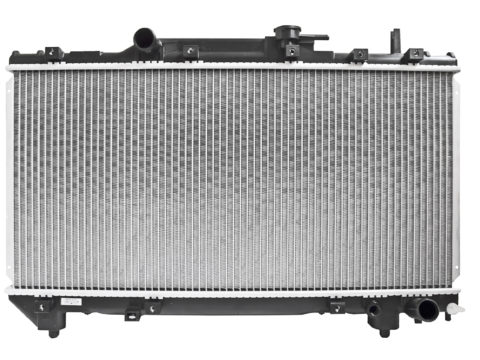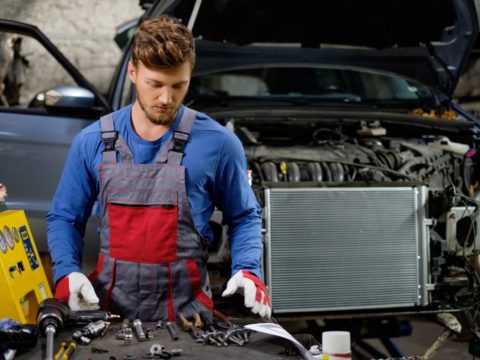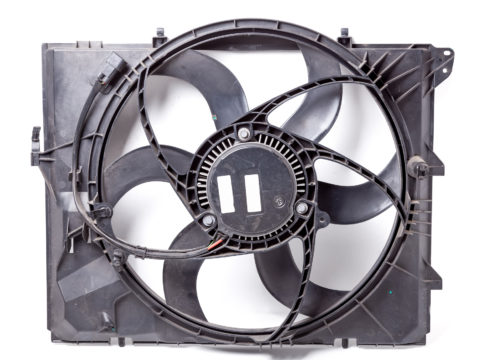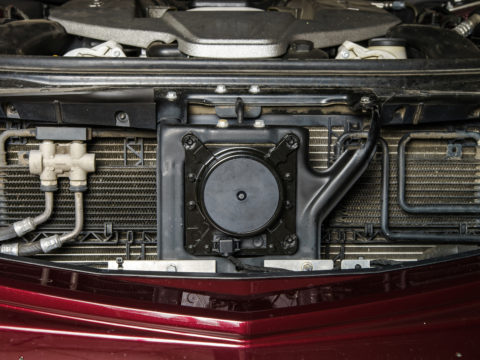Contents
Radiator Cap Overview
When it comes to radiator caps in vehicles, there are three main points you should know to tell if your vehicle’s radiator cap has gone bad or not.

Where Is It Located?
The radiator cap sits atop the radiator in the front of the car under the hood and is often near the engine. However, this is not always the case. Some car models have a design where the engine sits in the back as opposed to the front. In these cases, you might find the radiator in either the front or rear of the car.
Keep in mind that not all radiators come with a radiator cap, so if you do not see one, your vehicle may not have one.
What Does It Do?
Whenever a vehicle engine’s coolant gets hot, it spreads and raises the level of pressure within the vehicle’s coolant system. A radiator cap helps keep this spreading under control by adding consistent pressure to an engine. This pressure is different depending on both the engine and the radiator cap design.
In addition to maintaining control of an engine’s expansion, a radiator cap also helps coolant return to the radiator when the engine is cooling down. This allows a void effect to arise in the cooling system, and the coolant can then go back into the radiator.
What Are the Signs of a Bad Radiator Cap?
Now, let’s get into some of the signs you can look for to determine whether a radiator cap is bad or not.
Sign 1: The Engine or Radiator Cap Is Steaming
Whenever you see smoke or steam coming from a part of a vehicle, that’s almost always a surefire sign that something is wrong.
In the case of a radiator cap, when you see steam coming from it or the engine, this might indicate your radiator cap failing to help the vehicle’s coolant maintain the proper temperature. If this occurs, your radiator cap will get hot to the point where steam starts to come off it because the coolant is leaving the system.
It is also important to note that you may not see this if the hood of your car is down. So, if you lift your vehicle’s hood and see steam coming from the radiator cap or engine, that likely means your radiator cap is faulty.
Sign 2: Coolant Is Leaking Out of the Bottom of the Vehicle
Suppose you’ve ever parked somewhere and gotten out of your vehicle after driving, only to find a pool or stream of liquid beneath it. In that case, you’re probably seeing your vehicle’s coolant leaking.
Now, leaking coolant is not necessarily linked to your radiator cap being bad. A bad radiator cap could cause such a leak, but you will have to check it to see if it is the cause and not another part of your vehicle.
That said, the coolant should never leak from a vehicle, so you will want to identify the cause of the leak regardless of whether your radiator cap is the issue or not.
Sign 3: The Vehicle’s Coolant Supply Is Running Low
Assuming your vehicle is not leaking coolant, it should have more than enough coolant supply to run for a while. However, if you often have to add more coolant to the system, this is a potential sign that something is wrong with your radiator cap.
A vehicle’s coolant system is a closed system, so if it is functioning normally, it cannot lose coolant rapidly to the point where you have to refill it frequently. That only happens when something is wrong with the coolant system. If your vehicle is consistently low on coolant, try checking your radiator cap to see if anything is wrong with it.
Sign 4: The Coolant System Is Full of Air
As previously mentioned, the coolant system is a closed system, so nothing should get in or out of it. This includes air, as air getting into a vehicle’s coolant system can create air pockets.
While air pockets inside the cooling system might seem like a minor inconvenience, they can affect the system to such a degree that the vehicle’s engine will overheat. If your radiator cap fails to seal, this problem can occur, so make sure your radiator cap seals appropriately to avoid this issue.
Sign 5: Overheating Engine
Several things can cause a vehicle’s engine to overheat, and a faulty radiator cap is on that list.
Seeing as how leaking coolant and air in the coolant system can both lead to an engine getting dangerously hot, and a bad radiator cap can cause both of those problems, you can see how it directly relates to an overheating engine.
The best way to see if a bad radiator cap is the culprit of an overheating engine is to lift the vehicle’s hood and check the engine directly. Also, check the radiator cap to see if it is visibly damaged or has coolant around it.
Sign 6: White Streaks on the Radiator
You can tell if coolant is leaking from your radiator by looking for fluid beneath your vehicle, but you can also check the radiator cap itself.
Sometimes when a leak is just starting or is not very bad yet, you’ll find that the coolant is leaking but not getting out of the vehicle all the way. It is only getting out of the radiator and burning off before it can get to the ground.
To determine whether this is happening or not, check your radiator and see if there are any white streaks on it, as these are signs that coolant burned off.
Sign 7: The Vehicle’s Radiator Cap Hose Collapses
In some instances, the radiator cap hose will collapse from a bad radiator cap.
When the radiator cap hose collapses, check the cap to see if it sustained any damage, because a hose collapsing might come from the cap failing to allow the vacuum to send more coolant to the radiator to maintain proper temperatures.
If the radiator cap is damaged, it will likely need replacing for the hose to function again.
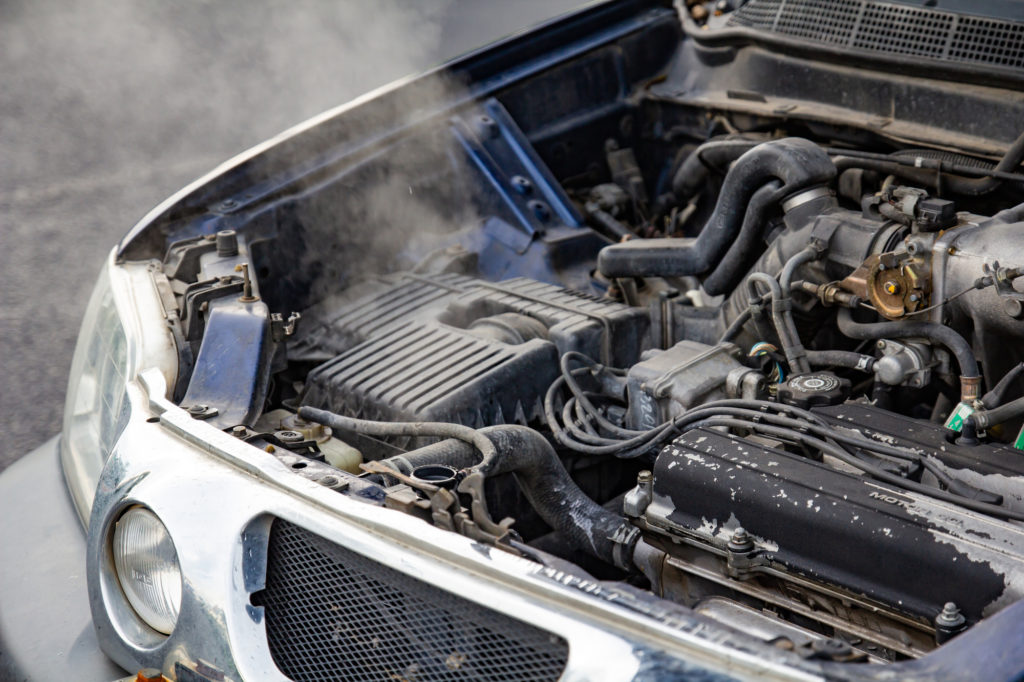
What Causes a Radiator Cap to Go Bad?
Next, let’s cover some things that can cause a radiator cap to go bad.
Reason 1: Bad Pressure
All cooling systems contain their own amounts of pressure, and they need to maintain whatever that specified pressure level is for them to function correctly.
If this pressure fails to stay at the specified level, the radiator may go bad and lead to a whole host of issues, many of which were covered above.
To avoid such a situation, a vehicle needs to have regular maintenance checks done to ensure the radiator cap is working at all times without issue.
Reason 2: Poor Vehicle Maintenance
When it comes to any part of a vehicle, maintenance is the ultimate trick to keeping damage at a minimum. Of course, this is easier said than done, since vehicle maintenance requires a fair amount of knowledge if you plan on carrying out routine maintenance checks yourself.
Suppose you don’t have the technical knowledge or time required to regularly perform adequate maintenance on your vehicle. In that case, you will want to at least take it to a professional to have maintenance checks done.
Not doing this can lead to issues like a radiator cap going bad and many more. So, it’s better to regularly check for problems and catch them in their early stages, than wait for them to grow noticeable.
Reason 3: Age
Another cause of radiator caps going bad is age.
Unfortunately, there is little to nothing you can do about this, aside from regular maintenance checks to keep a vehicle in the best shape possible for as long as possible.
Eventually, a radiator cap might give up due to accumulating age and rust, especially if it sees a lot of use during its lifespan. However, this is an infrequent occurrence, as radiator caps typically last for a vehicle’s entire lifespan.
To be on the safe side, check your radiator cap every six to twelve months at a minimum.
Reason 4: Overuse and Underuse
Lastly, overuse and underuse may cause a radiator cap to go bad eventually.
Similar to age and attrition, having a radiator cap go bad from overuse or underuse is a scarce occurrence, though it is not impossible.
Many things that go wrong with a vehicle don’t always have a cause that you can find. Sometimes a part will break or give up without any real explanation. A prevalent example of this is if a car does not run for an extended period. There is a high chance that when someone tries to turn the car on, the engine won’t start because the battery died out from being idle for too long.
Similarly, the cause of a bad radiator cap is sometimes beyond your control.
What Will Happen If You Drive With a Bad Radiator Cap?
Driving a vehicle with a bad radiator cap will cause overheating to happen rather quickly. The reason for this lies within the fact that the engine needs coolant to keep it cool, but the radiator pressure being low as a result of a broken radiator cap will make it unable to control the heat inside.
When Should a Radiator Cap Be Replaced?
A radiator cap needs replacing when any of the issues mentioned in the sections above arise due to the radiator cap being bad.
Sometimes a radiator cap is salvageable and fixable, but there are also times when it is completely beyond repair.
On average, a new radiator cap will cost between $10 and $50, but get the opinion of a professional before you deem a radiator cap beyond saving.

